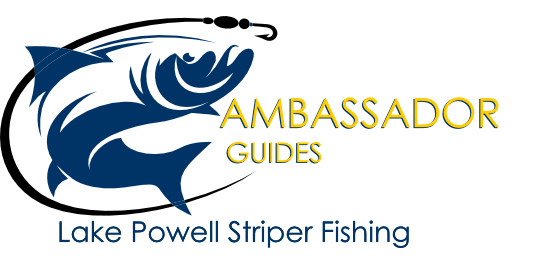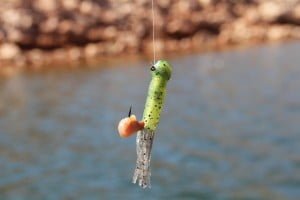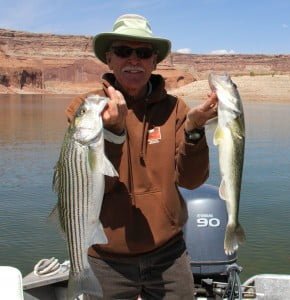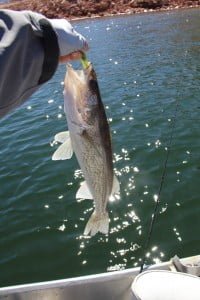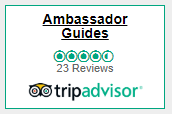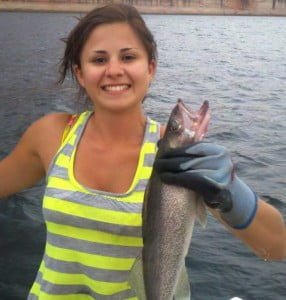There are three photos today. One shows Wayne Gustaveson holding a few of the walleye caught yesterday.
The next shows a green tube jig tipped with a piece of night crawler. Walleye like the taste of live worm and it helps to have a worm on the hook to get the bite.
The last picture shows a close up of a walleye being landed with that green tube in its mouth.
Lake Powell Fish Report – April 29, 2015 Lake Elevation: 3590.2 Water Temperature 61- 66F – May is Walleye Month
May is WALLEYE Month
Fishing at Lake Powell continues to get stronger as the water warms. It was 61-66 F today, which is primetime for spring fishing. Smallmouth are still king but striped bass are in the back seat now and walleye are riding shotgun.
Smallmouth bass are moving back on the spawning beds so bass fishing will be super this week.
Striped bass are thinking about spawning so they are active at night. The best time to catch stripers is at night or early morning in pre dawn light. They tend to quit biting when the sun peaks over the ridge and hits the water.
Walleye always come on strong in May because they are trying to rebuild their body after the stress of spawning. They are caught more often now because they feed all day long. Later in the summer after the other fish spawn there is plenty of forage for omnivorous walleye but in May they have to use available forage. It takes a full day of feeding to get that feeling of fullness they desire.
Walleye pattern:
Find colored water, usually toward the back of the canyon but sometimes along the bank where wind and waves stir up the sediment.
The proper walleye-catching depth is 12-15 feet. That works whether trolling, casting or dragging live worms. Find a bench, terrace or reef surrounded by deeper water. Work your bait along the breaking edge. As with most animals fish really like to have a close avenue of escape handy where they can dive quickly into deep water.
Trolling, casting, dragging or bottom bouncing will work. It is up to you to decide which is your preferred method.
Trolling: Tie on a 12-foot medium runner and drag it at 2-2.5 mph across the reef. Walleye are ambush feeders that will strike quickly as a trolled bait is in range. They really like to hide in a bush and hit fish that swim in close proximity. Therefore trolling near brush while hitting bottom occasionally is the most effective technique.
Bottom bouncing: Use the 12 inch long L-shaped weight with a worm harness, attractant spinners and beads to deliver the night crawler to the waiting walleye. The bouncer has a heavy weight to keep the worm near the bottom. The worm harness spinners attract attention and the worm usually has a couple of hooks that will impale the walleye as it strikes.
Casting or Drifting: Use a plastic grub jig, tube or worm on a jig head. They key is to keep the bait on the bottom while slowly moving along the bottom contour. It will soon become apparent how it feels when the lure hits a stick or rock and bounces off. Then the distinctive walleye bite will feel subtlety different as the bait is mouthed and then released…then picked up and dropped again. Walleye often bite many times before getting enough hook to be caught. The bite resembles a lure being grabbed by a rubber band, stretched and then released. The take home message is that when strange things happen to your lure on the bottom it is usually walleye related.
How important is the live worm? When the worm is lost to a walleye bite it seems wise to put another worm on to catch the fish. But at times the lure on bottom without a worm will work just fine. Live worms attached to the terminal tackle are really a matter of personal preference. If you think walleye will bite better with a worm attached then put one on. If you think it doesn’t matter then you don’t need one. All of the walleye caught casting today had a piece of worm attached. The one walleye caught trolling did not bite a worm.
Place a half-inch chunk of live worm on the hook with the plastic grub for taste and to build your confidence.
Oh! and one last caution:
When you hook the walleye do not put your hand in the fishes mouth. They have sharp teeth!
There are three photos today. One shows Wayne Gustaveson holding a few of the walleye caught yesterday.
The next shows a green tube jig tipped with a piece of night crawler. Walleye like the taste of live worm and it helps to have a worm on the hook to get the bite.
The last picture shows a close up of a walleye being landed with that green tube in its mouth.
